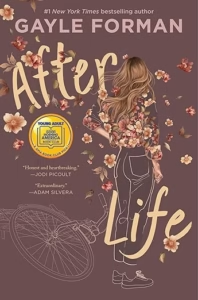After Life
Gayle Forman
Quill Tree Books
Published January 7, 2025
Amazon | Bookshop | Goodreads
About After Life
“After Life is a masterful tale about a family coping with loss, showing the way grief affects us and people we don’t even know in ways we don’t see. Once I met Amber and her family, I didn’t want to let them go.” -—Brigid Kemmerer, New York Times bestselling author of Carving Shadows into Stone
“Forman is a master at making her readers fall in love—with a girl whose life is over, with a community of people in a small town who are barely surviving her loss, and with the incredible, surprising way everyone’s stories knit together into a heartbreaking and hopeful whole.” —E. Lockhart, author of We Were Liars and Genuine Fraud
One spring afternoon after school, Amber arrives home on her bike. It’s just another perfectly normal day. But when Amber’s mom sees her, she screams.
Because Amber died seven years ago, hit by a car while on the very same bicycle she’s inexplicably riding now.
This return doesn’t only impact Amber. Her sister, Melissa, now seven years older, must be a new kind of sibling to Amber. Amber’s estranged parents are battling over her. And the changes ripple farther and farther Amber’s friends, boyfriend, and even people she met only once have been deeply affected by her life and death. In the midst of everyone’s turmoil, Amber is struggling with herself. What kind of person was she? How and why was she given this second chance?
This magnificent tour de force by acclaimed author Gayle Forman brilliantly explores the porous veil between life and death, examines the impact that one person can have on the world, and celebrates life in all its beautiful complexity.
My Review
The first novel by Gayle Forman I ever read was If I Stay. (Which, apparently, I never reviewed! Hmm.) My first thought about After Life was that it has a similar ethereal vibe to If I Stay.
In After Life, Amber returns, but there’s a veil between her and her past life, seven years ago. Some things about her life are fresh in her mind and still feel present to her, but to everyone else, she’s been gone seven years. Her return isn’t just miraculous; it’s jarring.
The story jumps around a lot from past to present and different perspectives. I kept everything straight easily, maybe because the chapters were so short. Maybe because the characters are all so different from one another. The story felt pretty straightforward like everything contributed to a whole.
Only one scene struck me as super weird. In it, the romance escalates quickly and suddenly halts. I thought that considering the history of the characters, it seemed strange that the scene played out that way. I just didn’t find it believable, especially as I continued reading.
The rest of the book had some hard-hitting emotional scenes. The town where Amber’s family lives has an It’s a Wonderful Life feel. Threads connect characters in sometimes surprising ways. One character’s actions have a ripple effect, impacting other people in the story. The way the narrative jumps around allows readers to focus on those threads and see how the characters are connected.
At the core of the story is a relationship between two sisters. Melissa and Amber had a complicated relationship before Amber’s death. Amber wants to make up for lost time and for the harm she has caused. The tenderness and acceptance between those two is my favorite part of the story.
The book also explores our different responses to grief. Forman wrote an insightful afterward that explains why she wrote the story and her thoughts on how we grieve. I loved the book before I read her note, but I loved it even more after reading it.
Conclusion
All in all, this is a good one, especially if you like books that break convention to explore a spiritual or relational idea. It’s also less than 300 pages, so a pretty quick read. I highly recommend it.
The cast of the story is pretty inclusive. It includes a person with severe allergies, several queer people, and people of color.
Content Notes for After Life
Recommended for Ages 14 up.
Profanity/Crude Language Content
Some profanity used.
Romance/Sexual Content
Kissing. References to sex and cheating on a partner. Some scenes describe nudity and, briefly, sex.
Spiritual Content
References to Christian faith and atheism. (One of Amber’s parents was an atheist before her death and appears to have a change of heart when she reappears. Her other parent kept faith as a core part of life, which Amber’s death appears to have challenged.) The family (minus Amber) attends church (off-scene) and speaks to their pastor about miracles.
Violent Content
A boy grabs a girl by the shoulders and shakes her. A man punches someone (several scenes reference this). References to an accident in which a car struck a girl on a bike, killing her. Her injuries are briefly described.
Drug Content
More than one character (adults) drinks too much alcohol or appears to be an alcoholic. A teen drinks alcohol. References to drug use or selling/buying drugs.
Note: This post contains affiliate links, which do not cost you anything to use but help support this blog. I received a free copy of this book in exchange for my honest review. All opinions are my own.
